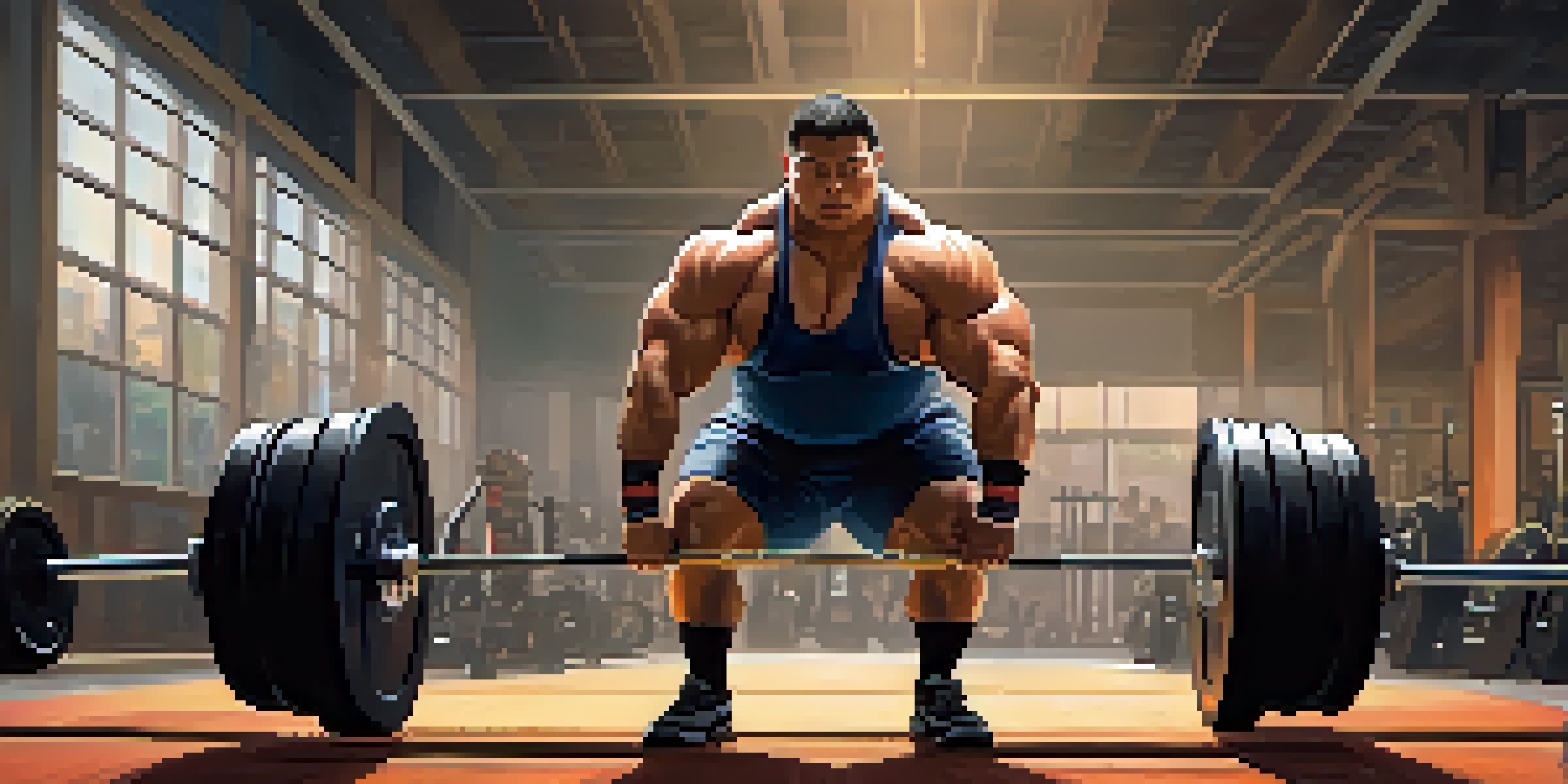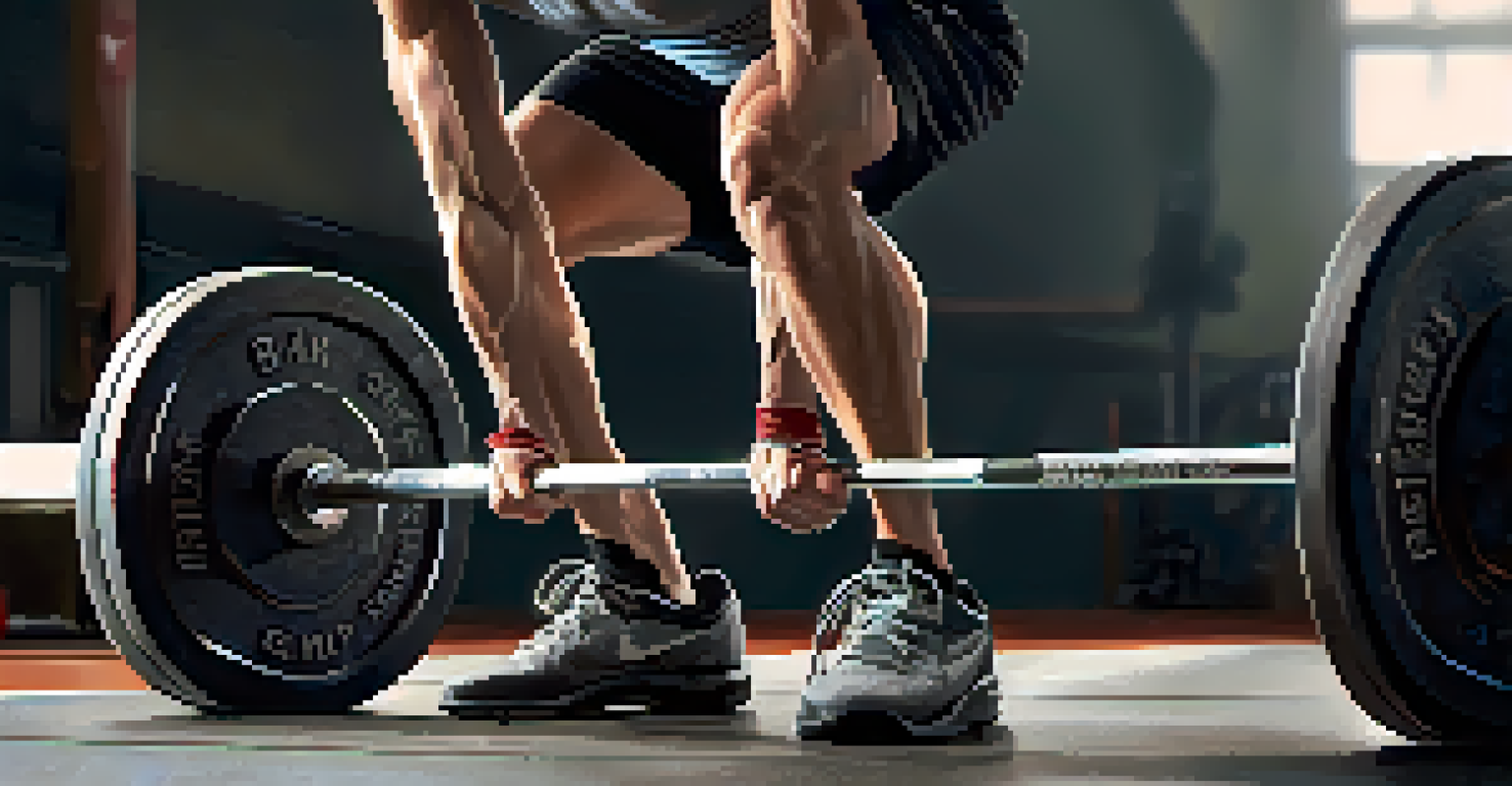Deadlift Variations for Powerlifters Facing Mobility Challenges

Understanding Mobility Challenges in Powerlifting
Mobility challenges can significantly impact a powerlifter's performance, especially when it comes to executing the deadlift. Factors such as tight muscles, joint restrictions, and previous injuries can create barriers to achieving proper form and maximizing lift potential. Recognizing these limitations is the first step towards finding effective solutions that can help powerlifters continue to excel in their training.
Strength does not come from physical capacity. It comes from an indomitable will.
For instance, a lifter with limited hip mobility may struggle to reach the optimal starting position for a conventional deadlift. This restriction can lead to compensatory movements, increasing the risk of injury. Therefore, it's essential to address these mobility issues while exploring adaptations that allow for safe and effective lifting.
Ultimately, understanding your body's unique mobility challenges will empower you to choose deadlift variations that suit your needs. By doing so, you can maintain your strength training regimen while minimizing the risk of injury and maximizing your performance.
The Importance of Proper Technique
Proper technique is crucial in powerlifting, especially for the deadlift, where improper form can lead to injuries. A solid foundation of technique not only optimizes lifting performance but also ensures safety. When dealing with mobility challenges, it becomes even more critical to focus on technique adjustments that accommodate individual limitations.

For example, if a lifter struggles to maintain a neutral spine due to tight hamstrings, they might need to modify their stance or grip. This adjustment can help maintain proper alignment and reduce strain during the lift. Addressing these technical aspects can make a world of difference in how effectively and safely a lifter can perform their deadlifts.
Mobility Impacts Deadlift Performance
Limited mobility can hinder a powerlifter's ability to execute proper deadlift form, increasing injury risk.
Always remember that prioritizing technique over lifting heavier weights will lead to long-term success. By making small adjustments and focusing on form, powerlifters can continue to progress despite mobility challenges.
Sumo Deadlift: A Friend to Limited Mobility
The sumo deadlift is an excellent variation for powerlifters facing mobility challenges, particularly those with limited hip and hamstring flexibility. By adopting a wider stance, the sumo deadlift allows lifters to engage different muscle groups while reducing the stress on the lower back. This position can feel more comfortable for those struggling with conventional deadlift setups.
The only way to discover the limits of the possible is to go beyond them into the impossible.
Additionally, the sumo deadlift encourages a more upright torso, which can benefit lifters who have difficulty achieving the required hip hinge in a conventional deadlift. This variation can help maintain proper spinal alignment and reduce the risk of injury. Lifters can gradually increase their range of motion as they improve their mobility.
Incorporating sumo deadlifts into your training routine can be a game-changer. By focusing on this variation, powerlifters can continue to build strength while working around their mobility limitations.
Deficit Deadlifts: Building Strength Gradually
Deficit deadlifts involve standing on a platform or plates, which can be beneficial for lifters with certain mobility issues. This variation allows lifters to increase their range of motion gradually, promoting strength development in the posterior chain. It's an effective way to work on deadlift mechanics while accommodating mobility challenges.
However, it's essential to approach deficit deadlifts with caution, particularly for those with limited mobility. Starting with a small deficit can help lifters focus on form while still challenging themselves. As their mobility improves, they can gradually increase the height of the deficit to continue progressing.
Technique Adjustments are Key
Focusing on proper technique adaptations is crucial for powerlifters to safely navigate their mobility challenges.
By incorporating deficit deadlifts, powerlifters can work on their strength and stability without compromising their safety. This variation can contribute to overall improvements in deadlift performance over time.
Trap Bar Deadlifts: A Versatile Alternative
Trap bar deadlifts are another fantastic option for powerlifters dealing with mobility challenges. This variation utilizes a hexagonal bar that allows for a more natural lifting position. By standing inside the bar, lifters can adopt a more upright posture, reducing strain on the lower back and hips.
Moreover, trap bar deadlifts often feel more comfortable for lifters with limited ankle mobility since they can maintain a more neutral foot position. This can lead to fewer compensatory movements and a safer lifting experience. It's also a great way to build overall strength while minimizing the risk of injury.
Incorporating trap bar deadlifts into your routine can provide a refreshing change of pace. This variation can help you continue progressing in your training while addressing mobility limitations.
Single-Leg Deadlifts: Enhancing Stability and Balance
Single-leg deadlifts are an effective way to improve balance, stability, and strength for powerlifters facing mobility challenges. By performing the lift on one leg, you can engage core muscles and enhance proprioception, which refers to your body's ability to sense its position in space. This variation can help address imbalances while providing a different stimulus to the muscles.
For those with limited mobility, single-leg deadlifts allow for modifications based on individual needs. Using a kettlebell or dumbbell can provide additional support and help maintain balance throughout the movement. As strength and stability improve, lifters can gradually increase the load and complexity of the exercise.
Variations Can Enhance Training
Incorporating deadlift variations like sumo and trap bar can help lifters work around mobility limitations while building strength.
Incorporating single-leg deadlifts into your training can lead to improved overall performance. This variation not only addresses mobility challenges but also helps develop better stability that can benefit other lifts.
Incorporating Accessory Exercises for Mobility
While deadlift variations are essential for powerlifters with mobility challenges, including accessory exercises can further enhance performance. Incorporating movements that target hip, hamstring, and ankle mobility can create a well-rounded approach to training. Stretching and mobility drills can help alleviate tightness and improve range of motion, making deadlifts feel more accessible.
For example, exercises like hip thrusts, glute bridges, and various stretches can significantly benefit mobility. These movements not only target the same muscle groups used in deadlifts but also help improve overall stability and strength. Consistently including these accessory exercises can lead to better results in your deadlift performance.

Incorporating a balanced routine that includes both deadlift variations and mobility work will set you up for long-term success. By addressing both strength and mobility, powerlifters can continue to progress while working around their limitations.
Consulting Professionals for Tailored Guidance
When facing mobility challenges, seeking guidance from professionals can be an invaluable step. A qualified coach or physical therapist can assess your individual needs and provide personalized recommendations tailored to your specific limitations. This expert guidance can help you navigate your training effectively and safely.
For example, a coach can analyze your movement patterns and suggest appropriate deadlift variations that suit your mobility challenges. They can also design a training program that incorporates both strength and mobility work, ensuring a comprehensive approach to your training regimen. This tailored guidance can lead to significant improvements in performance and confidence.
Ultimately, investing in professional advice can be a game-changer for powerlifters dealing with mobility issues. By working with experts, you can learn how to adapt your training to meet your unique needs and achieve your goals safely.